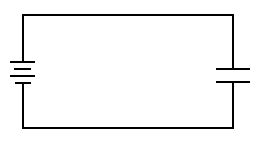BY LETTER
Capacitors
Technology > Technology Type or Material > Drytech/Hylotech
Technology > Technology Levels > Middle Tech / Midtech
Technology > Application > Power Generation
Technology > Technology Levels > Middle Tech / Midtech
Technology > Application > Power Generation
Capacitors have long been a standard element in Terragen technology. They are used as rechargeable power sources for vehicles and motile bots, powered tools, temporary or isolated dwellings, and wherever else electrical power is required but a permanent connection to a power transmission line is impractical. They are a popular personal power source for vecs or cyborgs. Capacitors also have several useful applications within electronic and electrical circuitry apart from simple storage of electrical power.
The technology of typical modern capacitors (sometimes known as hypercapacitors) dates back to the first century AT. At that time, advanced materials allowed unprecedented energy densities per unit area, and early nanotechnologies allowed the fine scale structures that permitted great increases in unit area per volume and fine control over rates of energy release. Expert onboard systems governed the charge and discharge of the units, as well as some limited self-repair and maintenance. By the early second century the designs that are still used today throughout the Terragen sphere had become ubiquitous.
Typical modern capacitors have energy densities of about 25 MJ/kg by mass or 50 MJ/L by volume. They can be rapidly charged from a variety of electrical power systems and can be induced to release their energy as electrical current, both at a rate of 50 kW/kg or 100 kW/L. Capacitors that remain unused in storage for long periods do eventually lose their charge, though they are quite adequate for medium term energy storage. If mechanical power is needed, the capacitor's electric output must feed into electric motors, which typically have specific powers of 10 kW/kg. Consequently, for mechanical applications that require high power outputs mechanical energy storage devices (such as torsion batteries or flywheels) are preferred. The main competitor of the capacitor as a source of electricity is the superconducting solenoid. While capacitors cannot match solenoids for peak power output, they do not require exotic metals or specialized switching systems to prevent arcing during discharge, so may be preferred for reasons of economy.
While they are resistant to physical impacts and chemical or nanotech destruction and operate over a wide range of temperatures, capacitors that are somehow compromised while charged will arc explosively, producing a blast of hot plasma and diamondoid shards. Those designed to operate under standard Terragen conditions typically have a corundumoid and carbon nanotube composite casing that
resists most hazards they are likely to encounter. Standard capacitors have low-grade sentient-level intelligence that allows them to adapt to a variety of charge and discharge systems, respond to a variety of simple user commands, carry out basic self-repair, and signal for help when they encounter problems they cannot solve.
Most nanofacs carry the programming to produce a standard capacitor. Many mechosystems are seeded with autonomous plantbots that produce capacitors in various sizes using local materials and energy sources; this is a popular strategy with vec or cyborg colonists.
Appears in Topics
Development Notes
Text by Stephen Inniss
additional comments by Luke Campbell
Initially published on 12 June 2007.
page uploaded 12 June 2007, last updated 24 December 2007
additional comments by Luke Campbell
Initially published on 12 June 2007.
page uploaded 12 June 2007, last updated 24 December 2007







